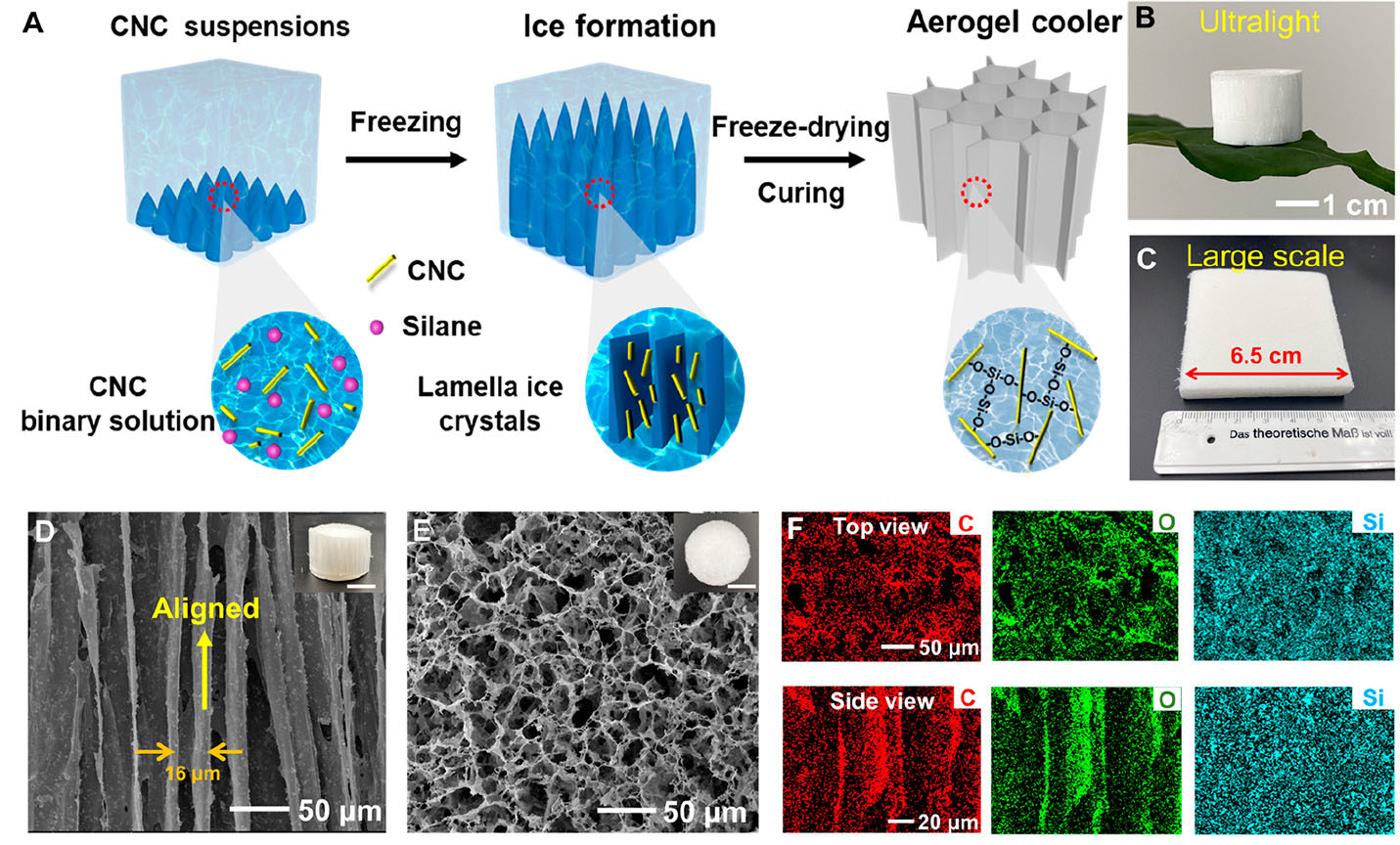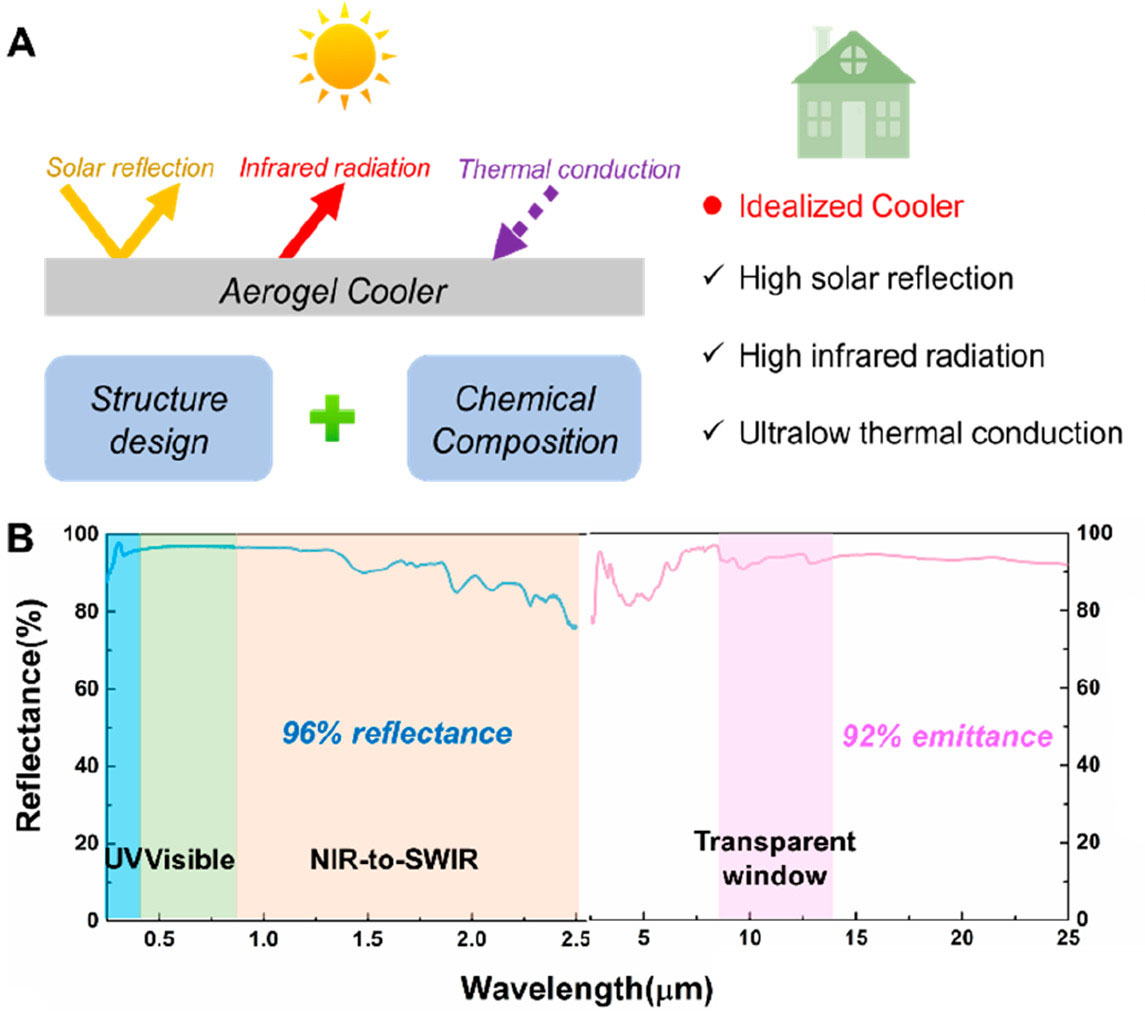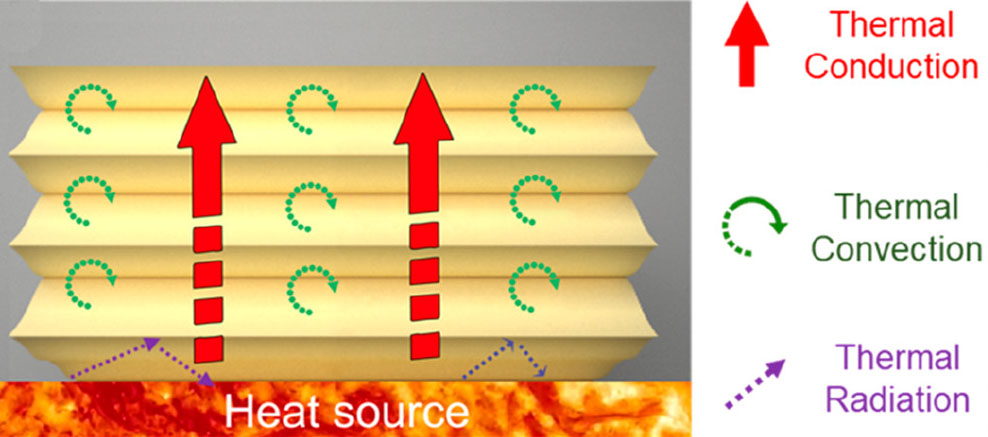| Jun 16, 2022 | |
Novel cellulose aerogel radiative coolers for building applications |
|
| (Nanowerk Spotlight) The development of efficient cooling technology based on environmentally friendly and biobased materials is crucial to our day-to-day activities, such as food preservation, air conditioning, refrigeration, large-scale computation as well as human comfort. At present, traditional vapor-compression technology is commonly used for cooling. However, it consumes significant amounts of electrical energy and the typical gaseous media used in compression either depletes the ozone layer or has a strong greenhouse effect (read more: "Passive daytime radiative cooling: Principle, application, and economic analysis"). | |
| Moreover, such a cooling procedure only causes heat to move from one location to another, together with converting work to heat. Therefore, the net effect is actually overall heating instead of cooling, leading to various issues such as the creation of urban heat islands and thermal pollution. These issues are getting even more worrisome in the context of global warming, which creates an increased energy demand for cooling purposes. | |
| In contrast, passive radiative cooling is a process by which objects naturally shed heat in the form of infrared radiation from the Earth's surface through the atmosphere to outer space, without consuming energy. Radiative-cooling materials utilize the planet's atmospheric transparency window (i.e. a range of wavelengths over which there is relatively little absorption of radiation by atmospheric gases; the major windows are the visible window, from ∼0.3 to ∼0.9 µm; the infrared window, from ∼8 to ∼13 µm; and the microwave window at wavelengths longer than ∼1 mm) to passively dissipate heat based on the large temperature difference between Earth's surface (~ 300 K) and outer space (~ 3 K). | |
| The immense potential of this technology to save energy and reduce CO2 emissions has attracted broad-based interest arising from both fundamental sciences and real-world applications, ranging from passive cooling of buildings, renewable energy harvesting, cooling systems on farms and passive refrigeration in arid regions. | |
| Radiative sky cooling has been explored for decades but so far has been limited mostly to nighttime use (read more this technology: "Radiative sky cooling: Fundamental principles, materials, and applications"). Daytime radiative cooling has been demonstrated as well (see for instance: "New metamaterial can cool roofs, structures with zero energy consumption", "Self-cooling solar cells boost power, last longer", and "Cooling in color") but, especially under direct sunlight, remains a technical challenge. This is due to the occurrence of strong solar absorption over infrared emission, which in turn, imposes stringent requirements on materials to possess extremely low absorptivity in the highly intensive solar spectrum (0.3–2.5 µm), while having high emissivity in other wavelengths, preferably within the atmospheric infrared window (8–13 µm). | |
| To find a solution to this problem, several daytime radiative cooling materials have been suggested to reflect most of the sunlight such that the heat absorption from the sun is below the level of radiative cooling. These include bulk dielectric multilayers, dielectric micro-sphere coatings, polymer-based PDRC coatings and paints, coating surfaces with some surface textural patterns (such as grating patterns, and wrinkles), selective emitters, hybrid metamaterials, and photonic structures. | |
| A key challenge for developing high-performance coolers is the tendency of some materials under the direct sun to absorb a significant amount of heat; other materials do not perform well in hot, humid or cloudy weather. In view of this, it is highly desirable to design well-suited radiative coolers that meet the requirements under various meteorological conditions. | |
| To surmount these challenges, a team of researchers from China and Germany has jointly designed and realized thermally insulating aerogel coolers based on cross-linked cellulose nanocrystals (CNCs) that can achieve efficient cooling, meeting the aforementioned, multifaceted requirements | |
| They report their findings in Nano Letters ("Dynamically Tunable All-Weather Daytime Cellulose Aerogel Radiative Supercooler for Energy-Saving Building"). These aerogel coolers can achieve a subambient temperature drop of 9.2 °C under direct sunlight and reach a reduction of ∼7.4 °C even in hot, moist, and fickle extreme surroundings. | |
| The unique feature of this efficient cooler is that it simultaneously acts as a thermal insulator as well as a daytime passive radiative cooler, integrating and performing dual functions in a single design. | |
| The scientists based the selection of this CNC aerogel cooler on: 1) strong solar reflectance throughout the solar spectrum (0.25−2.5 µm); 2) high and selective infrared emittance in the mid-infrared region (8−13 µm); 3) construction of aerogels endowed with ultralow thermal conductivity to reduce thermal convection from ambient surroundings to the inner space; and 4) structural integrity to meet the increasing demand for stringent conditions. | |
| The first step for making the building blocks of CNCs involves a hydrolysis process using H2SO4 and dispersing it in water. The so obtained CNCs typically showed a rigid rod shape (Figure 1A). Subsequently, the researchers added silane agents to the CNC suspension, which resulted in cross-linking the cellulose nanocrystals with a silane bridge. The well-dispersed suspension was unidirectionally freeze dried to produce aerogel coolers consisting of a stiff−flexible cross-linked three-dimensional network with aligned morphology. Finally, the obtained CNC aerogels were thermally cured at 80 °C. | |
 |
|
| Figure 1. Construction and characterization of aerogel coolers. (A) Preparation process for aerogel coolers. (B) Ultralight nature. (C) Upscaling potential. (D) Interior structure of aerogel coolers. The scale bar of inset picture is 1 cm. (E) Top surface morphology of aerogel coolers. The scale bar of inset picture is 1 cm. (F) Mapping images of aerogel coolers in top view and side view. (Reprinted with permission from doi:10.1021/acs.nanolett.2c00844, American Chemical Society) | |
| The porous hierarchical structured foam endowed the aerogel coolers with ultralight characteristics, resulting in a density of around 9.4 mg/cm3. The aerogels can be molded into different shapes, such as solid cylinder, solid cube and cuboid and a relatively simple upscaling of the fabrication is feasible. | |
| The team employed scanning electron microscopy (SEM) to critically examine the surface and interior structure of the aerogel coolers. The found that the aerogels exhibited unique aligned channels with anchored SiO2 nanoparticles across the longitudinal section (Figure 1D). | |
| In addition, the aerogel coolers displayed perceptible porous morphology in conjunction with interconnected pores as observed in the transverse cross-section, (Figure 1E). The porous and longitudinal aligned channels are formed due to the directional ice growth during the unidirectional freezing step. As shown in Figure 1F, the C, O, and Si elements were identically detected in mapping images (cross-sectional and longitudinal sections), which further validates the presence of cross-linked homogeneous CNC-silane networks. | |
| Unlike traditional aerogel coolers, the thermal-insulating CNC aerogel coolers in this work synergistically integrate high solar reflectivity, high emissivity, and low thermal conduction in a single design, which contribute to a spectacular increase of heat transfer (Figure 2A). | |
| Especially, the gel's white color suggests the superior scattering property of visible light, which can be explained on the basis of the peculiarly designed structure and chemical bonding of CNCs. The outstanding combination of chemical bonding and the unique morphological design strategy of CNC aerogel coolers has resulted in high reflectivity of 96% in the visible-light region and high emissivity of 92% during the atmospheric transparent window, as demonstrated in real-time measurements (Figure 2B). | |
 |
|
| Figure 2.Daytime radiative cooling performance of aerogel coolers. (A) Proposed mechanism of outstanding cooling performance of aerogel coolers. (B) Spectral UV−visible−infrared reflectance/emittance of aerogel coolers presented against the AM1.5 solar spectra and the atmospheric transparent window. (Reprinted with permission from doi:10.1021/acs.nanolett.2c00844, American Chemical Society) | |
| The solar reflectivity of the CNC aerogel coolers is much higher than that of most other radiative cooling materials mentioned in previous studies, namely: PVDF membranes, PEG membranes, PDMS fibers, cellulose bulk, textile, PEG aerogel and white wood. | |
| Another remarkable feature of this aerogel cooler is that when it is compressed, its cooling potential decreases as a result of its tuneable (mechanically adaptive cooling performance) attributes. As shown in Figure 3 at the left, at different compression strains (30,60, and 90%), the aerogel cooler displayed distinct cooling performance in real-world applications. The variable cooling ability decreased with increasing strains from 30% to 60% to 90%. | |
| Even under dynamic compressive tests the CNC aerogel material shows excellent mechanical stability with very minimal plastic deformation at temperatures ranging from room temperature to about 200 °C. | |
| As investigated and reported by the inventors, it should be pointed out that the reflectance and infrared emittance of aerogel coolers at different compression strains did not significantly change. Therefore, the researchers attribute the changes in cooling performance to the variation in thermal conductivity due to the deformed nano-/microstructures inside the aerogel: When the aerogel is subjected to compression, the air gaps between layers are minimized and the distance between layers decreases, resulting in elevated thermal conductivity from 0.029 W/mK to 0.038 W/mK to 0.056 W/mK, as shown in Figure 3 on the right. | |
 |
|
| Figure 3. Tuneable cooling performance of aerogel cooler. Left: Daytime radiative cooling performance of aerogel coolers at different compression ratios. Right: Thermal conductivity of aerogel coolers at different compression ratios. (Reprinted with permission from doi:10.1021/acs.nanolett.2c00844, American Chemical Society) | |
| The researchers note that their aerogels exhibit an excellent humidity-adaptive property, which allows them to be used under diverse climate conditions, especially at high relative humidity. | |
| As illustrated in Figure 4 below, the impressive thermal insulating character of the aerogel coolers can be attributed to the following: | |
|
|
|
 |
|
| Figure 4. Processes ascribed to thermal insulating property of aerogel coolers. (Reprinted with permission from doi:10.1021/acs.nanolett.2c00844, American Chemical Society) | |
| The authors point out that energy consumption modeling of the aerogel coolers in buildings in China showed a 35.4% reduction in cooling energy. | |
| In conclusion, this tuneable cellulose aerogel radiative super cooler is very promising for meeting different cooling requirement in various regions all over the world and in distinct weather conditions by simply changing the compression ratios. | |
| The innovative strategy of using CNC aerogels shows great potential for developing a cost-effective, tailor-made, high-performance and sustainable radiative cooling technology towards reduction in global warming and energy consumption. | |
|
By Yashwant Mahajan, Associate Editor, Nanowerk
|
|
|
Become a Spotlight guest author! Join our large and growing group of guest contributors. Have you just published a scientific paper or have other exciting developments to share with the nanotechnology community? Here is how to publish on nanowerk.com. |
|
